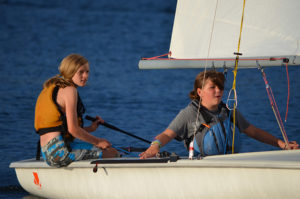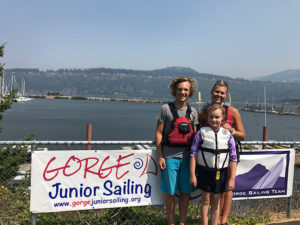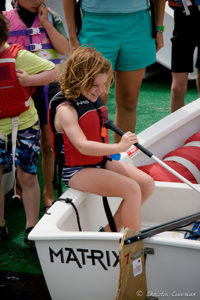Payment Questions
Lifejacket & Swimming Questions
What kind of PFD (life jacket) is best?
Sailing/kayak style. Properly fitting personal floatation devices (PFD) must be worn at all times while on the docks, on the beach, and while sailing.
West Coast Sailing has a great selection for kids & adults: https://www.westcoastsailing.net/default/apparel/categories/life-jackets.html
Good examples of properly fitting PFDs:
Can I wear a waist-style inflatable PFD that I use on my SUP?
No, unfortunately these are not appropriate for using while sailing dinghies. If it’s manually inflating, and the sailor becomes unable to inflate the PFD, then the PFD will not be able to assist them when needed. If it’s an automatic inflating PFD, there is a chance it will automatically inflate at an undesired time while sailing and hinder sailing ability.
Do students need to know how to swim?
Yes. Safety is our priority. All students need to be comfortable swimming in a life jacket/PFD.
Class Questions
What is the swim check & capsize drill?
Please keep in mind that students will be getting wet! Students will practice capsizing and swimming while wearing life jackets. Swim check is intended to acclimate students to the cold, murky water and observe their comfort level in the water. The capsize drill will familiarize them with safe capsize recovery. Swimming in the river presents new circumstances and is not like swimming in a pool. Safety is first and foremost in the minds of the instructors.
On the first day of all classes, instructors will conduct swim checks and capsize drills for all participants to ensure that the student is comfortable in the water. All students are required to complete the swim check and capsize drill in order to participate in classes. To pass the drill, students are required to swim 10 yards, climb into a youth sailboat and purposely capsize the boat. The student then swims around and rights the boat, and swims back to the dock. This is done under the supervision of our trained instructors and the students will be coached through the entire process. Students are given on-land instruction and time to practice so they can successfully complete the drill.
Be aware of your child’s swimming ability and get lessons ahead of time if he/she is not a strong swimmer. A practice session in the river prior to class can also be helpful!
Minnows students are NOT required to do the swim check and capsize drill, however students are encouraged to participate in a fun “life jacket float test” in the water alongside the dock.
NOTE: No one shall swim under docks or near docked boats.
What are the Instructor qualifications?
All of our instructors maintain the following:
- US Sailing Small Boat Level 1 Sailing Instructor Certification.
- 4-day, 40-hour course. Topics covered in the course include: classroom and on-the-water teaching techniques, risk management, safety issues, lesson planning, creative activities, ethical concerns, and sports physiology and psychology.
- Boater Education Card.
- Oregon State Marine Board & NASBLA approved boater safety & education course.
- Current U.S. First Aid and Adult/Child CPR certificates.
- Yearly CDC HEADS UP Concussion in Youth Sports course.
- SafeSport Training.
- Educational and awareness program focused on safe, respectful sporting environments, free of abuse and harassment. Developed by the US Olympic Committee, SafeSport is now required training for all US Sailing Level 1 certified instructors.
- Current US Sailing membership.
- As the National Governing Body for the sport of sailing, US Sailing’s mission is to provide leadership for the sport of sailing in the United States.
Can I bring a friend to class?
Unfortunately, due to liability, GJS cannot allow guests in sailing classes. Medical reports, swim tests, enrollment fees, life jackets, knowledge of the water, and boat availability all prevent guests from attending classes. Instead, encourage your friends to sign up and bring your friends and family to Monday Night Open Sailing!
Can I watch my child sail?
Please keep in mind that parents on the docks and on the water can be a big distraction for new sailors (they’ll watch you instead of paying attention to class!). For safety reasons it’s very important for new sailors to focus entirely on their coach and the instruction.
If you’d like to watch your child’s class, we recommend watching from the marina spit, from the launch ramp parking area, or from the grass adjacent to DMV. We respectfully request that you do not hover and interfere with the class instruction. Thank you for your understanding.
A great opportunity for watching your child sailing up close is during Monday Night Open Sailing. You can even get in a boat with your child and let them show you first hand what they’ve learned!
How does my child advance to the next class level?
Sailing is unique because simply taking a course does not automatically qualify them for the next in sequence. Specific skills must be mastered before advancing to the next level.
Our instructors track students' skills and readiness to advance. Our priority is to keep sailing fun and safe for all the kids in our program. There are many important skills and concepts to learn in Beginners, before moving up to the Intermediate class. Most of our students take Beginner and Intermediate classes at least twice. Sailing in the Gorge can be quite windy and challenging. Advanced classes will sail in more challenging winds and waves. For safety reasons, and to maintain the child's interest, we only advance students to the next level when fully ready. Putting a child into Intermediates or Advanced too early can often turn them off of sailing, rather than boost their interest level.
We also offer private lessons. Often one-on-one attention can help kids master a particular skill or cover concepts that they may have missed in the group setting.
Our priority is for everyone to have a successful & fun sailing experience!
Which class is right for my child?
All of our classes are geared for a specific age, and experience level. Please take the time to read through the class descriptions before signing up.
Where are classes taught?
Meeting place for classes is at the Hood River Yacht Club, located on East Port Marina Drive. Instruction takes place outdoors on the lawn next to the Hood River DMV office and on the south basin dock. Sailing takes place in the Hood River Marina and on the Columbia River.
Hood River Yacht Club: located in the SW corner of Hood River Marina, across from the History Museum of Hood River County. Drive past the museum and find the entrance to HRYC on the right, just before the locked gate down to the docks. 300 East Port Marina Drive, Hood River is the address for the History Museum and the best address to use for Google Maps or smartphones.
Will classes be cancelled or rescheduled due to no wind?
Sailing classes will begin at the scheduled time regardless of the weather conditions. All classes will be held rain or shine, heavy winds or no wind. If weather prevents sailing, appropriate onshore instruction and activities will be conducted. Classes will not be canceled or rescheduled due to weather. Refunds are not provided due to weather or lack of wind. Thank you for your understanding.
What gear should students bring to class?
(Please be sure to label belongings with name & phone number! Instructors are not responsible for loss or damage to personal property of the student.)
- Properly fitting life jacket (PFD) – sailing or kayaking style.
- ***Minnows parents need their own life jackets too!***
- Closed-toed shoes that can get wet. No flip-flops please!
- Clothing that can get wet and appropriate for water temp/weather conditions.
(Rashguards, wet suit – shorty or wetsuit shorts or top, etc. Avoid cotton!) - Sunscreen!
- Water bottle (Dehydration is serious!)
- Sunglasses, hat/visor
- Towel & change of clothes
- Snack


